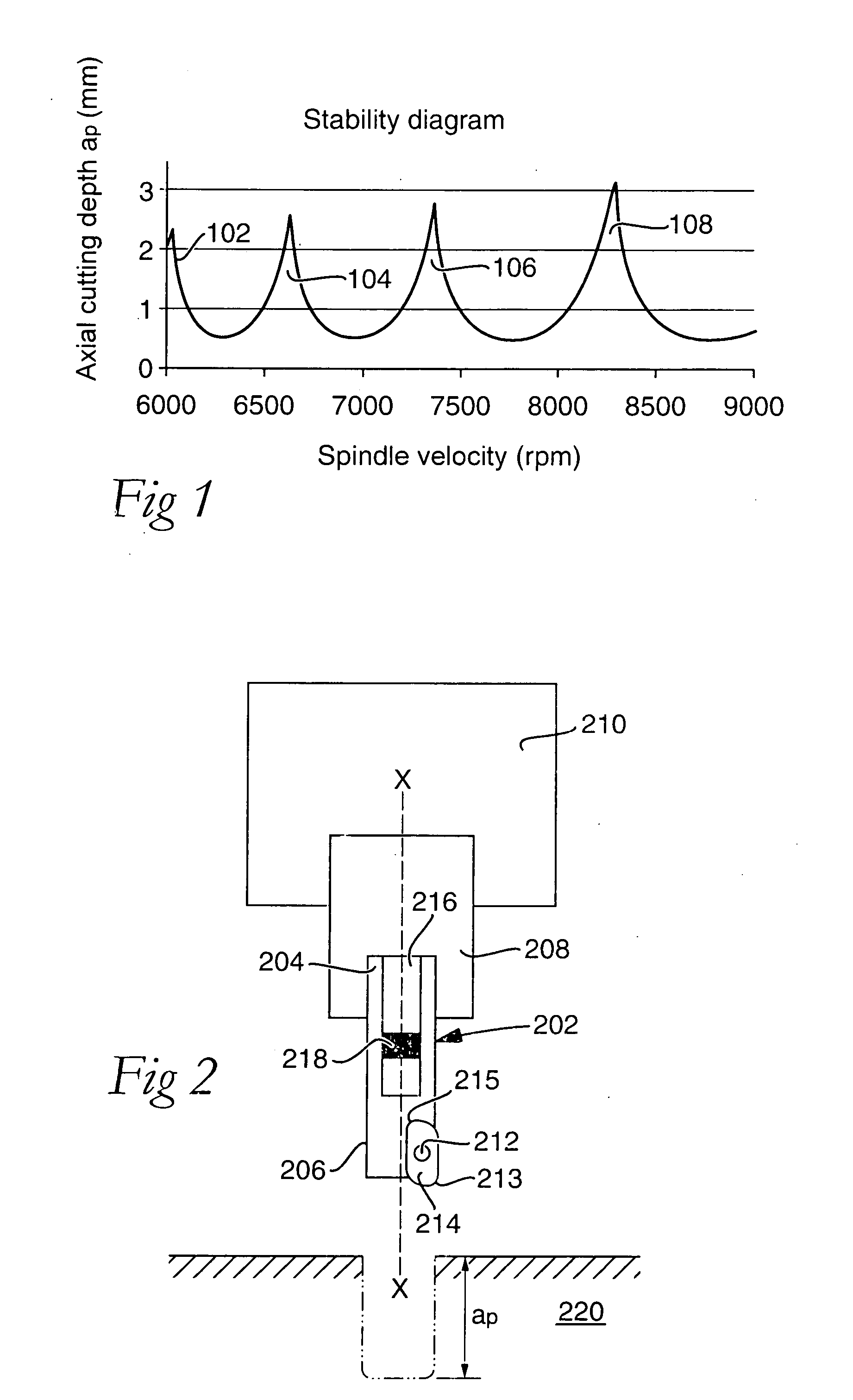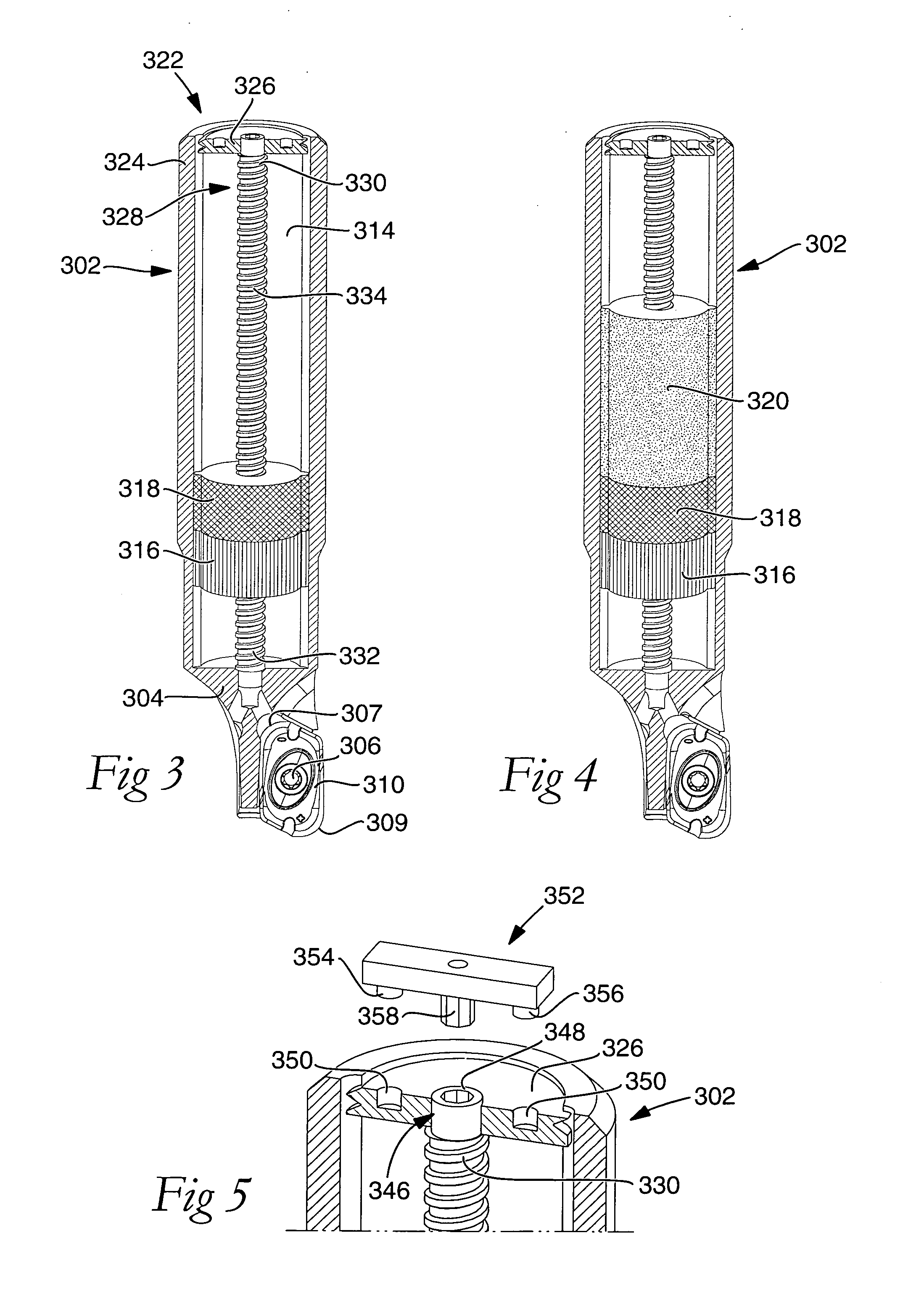Device and method for milling of materials
a technology of a milling device and a material, which is applied in the direction of shaping cutters, manufacturing tools, percussive tools, etc., can solve the problems of not always being able to change the spindle speed, not always being able to carry out a stable milling operation, and poor and irregular finish of the surface of the milled material, etc., to achieve even more efficient milling, improve the effect of milling, and flexibility in the tuning of the natural frequency
- Summary
- Abstract
- Description
- Claims
- Application Information
AI Technical Summary
Benefits of technology
Problems solved by technology
Method used
Image
Examples
first embodiment
[0059]FIGS. 3-6 schematically show a milling tool for chip removing metal machining including an elongate milling cutter body 302 of the device, wherein the milling cutter body 302 at the second end portion 304 thereof is provided with mounting members 306 for mounting of an edged milling insert 310 peripherally on the milling cutter body 302 in a pocket. Here, the milling insert 310 is provided with two cutting edges 307, 309 and is accordingly indexable into two different active positions, but may be provided with one or more than two cutting edges. The mounting members 306 for a milling insert 310 have a conventional design and embrace in this case a fastening element 306 that is adapted to engage with a recess arranged in the milling insert 310 and is anchored in a fastening hole mouthing in the bottom surface of the pocket in the milling cutter body 302, for example, by threads. The milling cutter body 302 is provided with a central axial hole 314 that extends along the longitu...
third embodiment
[0065]FIG. 8 shows a milling cutter body 502 of the device, wherein the axial hole 504 of the milling cutter body 502 along essentially the entire axial extension thereof, from the first end portion 506 of the milling cutter body 502 to the second end portion 508 thereof, where the mounting members 510 of the milling cutter body for mounting of an edged milling insert 514 peripherally on the milling cutter body 502 are located, is provided with internal threads 518 constituting the first threaded members 518. The second threaded members 520, which together with the first threaded members 518 form tuning members and locking members, are arranged peripherally on the mass element 522 in the form of external threads. The mass element 522 is provided with an indentation 524 having, for instance, a hexagonal internal cross-section, or another non-circular cross-section, with which a tool is adapted to engage so as to, by rotation of the mass element 522, tune the axial position thereof, a...
fourth embodiment
[0066]FIG. 9 shows a milling cutter body 602 of the device, wherein the milling cutter body 602 at the first end portion 604 thereof is mountable in a rotatable spindle and is, at the second end portion 606 thereof, provided with mounting members 608 for mounting of an edged milling insert 612 peripherally on the milling cutter body 602. In an axial hole 616 arranged in the milling cutter body 602, the mass element is 618 arranged and has also here a smooth envelope surface and has a radial extension corresponding to the internal cross-section of the axial hole 616, whereby the mass element 618 is radially locked so that its radial motion in relation to the milling cutter body 602 is prevented. The tuning members of this embodiment include driving members in the form of a helical compression spring 620 arranged between the mass element 618 and the second end portion 606 and adapted to drive the mass element 618 toward the first end portion 604. The tuning members include in addition...
PUM
| Property | Measurement | Unit |
|---|---|---|
| mass | aaaaa | aaaaa |
| natural frequency | aaaaa | aaaaa |
| length | aaaaa | aaaaa |
Abstract
Description
Claims
Application Information
 Login to View More
Login to View More - R&D
- Intellectual Property
- Life Sciences
- Materials
- Tech Scout
- Unparalleled Data Quality
- Higher Quality Content
- 60% Fewer Hallucinations
Browse by: Latest US Patents, China's latest patents, Technical Efficacy Thesaurus, Application Domain, Technology Topic, Popular Technical Reports.
© 2025 PatSnap. All rights reserved.Legal|Privacy policy|Modern Slavery Act Transparency Statement|Sitemap|About US| Contact US: help@patsnap.com



